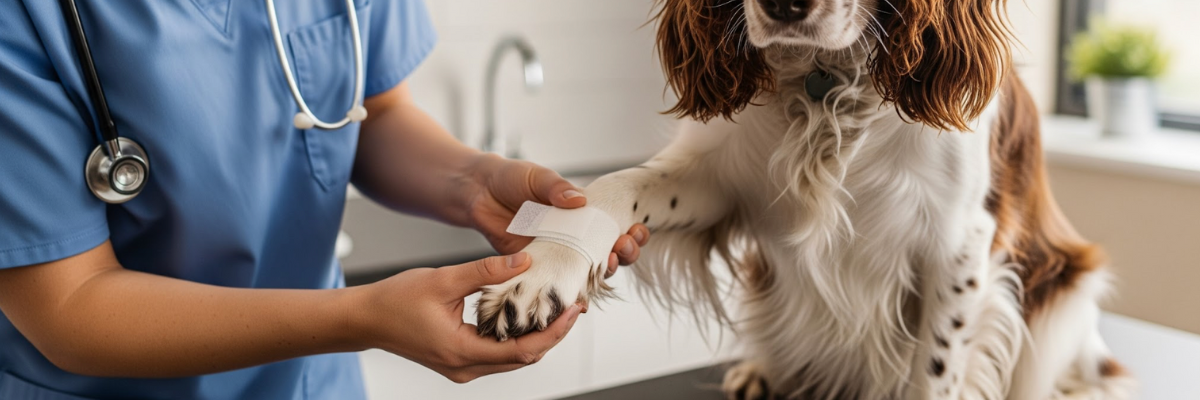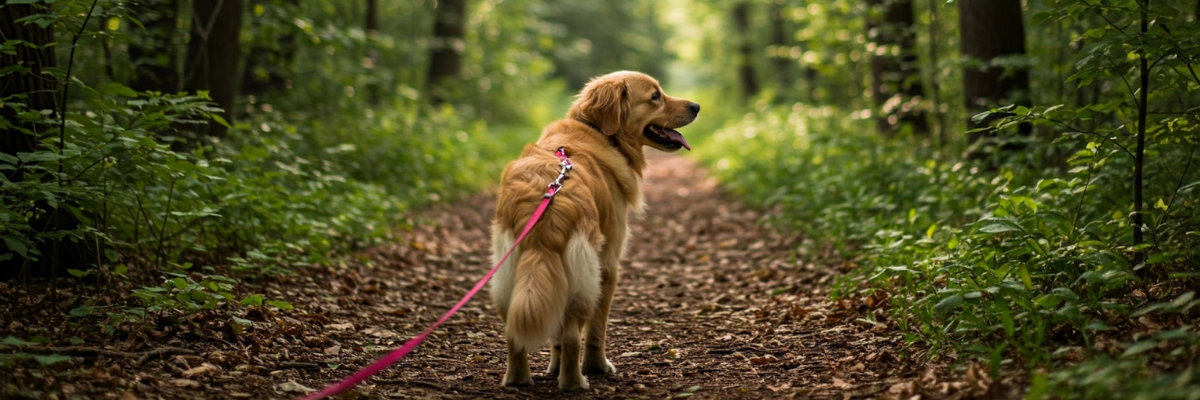Wound care
Accidents can happen – do you know what to do when your dog gets a wound or skin infection?
It's important to know the basics of wound care, as quick and proper first aid can often prevent more serious problems. Here are a veterinarian's top tips for correct wound care!
Clean the wound quickly and thoroughly
Thorough cleaning of the wound as soon as possible after the injury is essential to prevent infection. This cannot be emphasized enough – a non-infected wound heals quickly and relatively painlessly. Dirty wounds should first be rinsed clean of coarse dirt with running water (recommended rinsing time is 5–10 minutes). Always use lukewarm water and gentle pressure.
If anything foreign remains in the wound (such as splinters, sand, etc.), it can trigger a foreign body reaction, preventing proper healing and prolonging the issue. All foreign material should be removed carefully and promptly (with rinsing and tweezers, for example). If the dog is in too much pain to allow this without posing a risk to you, a veterinarian should clean the wound under anesthesia. If you’re unsure how to assess the situation, always contact a vet for guidance.
Stop the bleeding
If the wound is bleeding heavily, stopping the bleeding is the top priority. Heavy, bright red bleeding often indicates a need for immediate veterinary care. Stay calm and handle the dog with steady, confident movements. Immobilize the animal and apply pressure to the wound with a clean towel or paper towel if no dressings are available.
For wounds on a limb, a pressure bandage can be applied directly to the wound area temporarily. If bleeding is very heavy, a makeshift tourniquet can be used above the wound (max 10–15 minutes). Cold also helps reduce surface blood flow – if you don’t have an ice pack, a bag of frozen vegetables works well. If the area is thinly furred, place a few sheets of paper towel or a thin cloth between the ice and the skin to avoid frostbite. Never rinse a heavily bleeding wound with water, as this prevents clotting.
"Don't put anything in a wound that you wouldn't put in your eye."
After rinsing – and also for continued care – the wound can be disinfected, but only with antiseptic products that are safe for use in open wounds. Many so-called wound or antiseptic sprays are not suitable for open wounds; they are intended for intact skin and often contain alcohol, which stings and irritates and may even delay healing. If you wouldn’t put it in your eye, don’t put it in a wound.
My personal recommendation for wound disinfection is Vetericyn Plus wound spray – it’s water-based, effective, non-stinging, and doesn’t damage tissue. If a proper antiseptic isn't available, just rinsing a fresh wound with clean water is a better option than using the wrong product.
Protect the wound – especially from dirt and licking
Most dog wounds occur on the paws. So, learn how to make a proper paw bandage!
-
Place a clean (preferably non-stick) wound pad over the cleaned wound and secure it with wound tape.
-
Create long “brake strips” from wound tape by folding it back on itself – these anchor the bandage to the fur and help keep it in place.
-
Wrap several layers of cotton padding (from the pharmacy) around the paw to prevent pressure injuries – also place padding between the toes and dewclaws.
-
Finish with a self-adhesive bandage (e.g., Funflex, Leukoplast, Micropore, Petflex), applied snugly thanks to the underlying padding.
Always use an Elizabethan collar (cone) to prevent licking. Outdoors, protect the paw bandage with a child’s rain mitten or a dishwashing glove – a wet or saliva-soaked bandage is the worst case, as it promotes moisture buildup and worsens the wound.
As the wound heals
A clean, non-infected wound heals quickly and with little pain. When the wound stops oozing and begins to dry and form new scar tissue, you can begin reducing the protection – bandages can trap moisture and somewhat impair normal blood flow. Indoors, you can leave the wound uncovered or use a regular sock to protect it – as long as licking is prevented.
Small, well-cleaned wounds often heal without stitches. Larger wounds can also heal without sutures, but it takes much longer, so stitching is usually recommended to speed up recovery. Even a small wound is worth stitching if it's in a highly mobile area (e.g., paw pads) and the injury just occurred. Eyelid wounds should always be checked by a veterinarian, as stitches may be necessary to preserve normal eye function. The eye itself should also be checked for damage. When in doubt – let an expert examine the wound.
Summer problem in dogs: Hot spots
Hot spots – moist, superficial skin infections – can often be treated at home if caught and managed correctly.
If you notice your dog biting, licking, or scratching one area repeatedly, check the skin for signs of a hot spot (a moist, inflamed patch). Your nose can help too – hot spots often smell bad! This is a common summer issue, especially in thick-coated or water-loving dogs. Sometimes it starts with a small, insignificant skin injury hidden under thick fur, and excessive licking creates the perfect conditions for infection. Common sites are the base of the tail, behind the ears, and along the back.
How to treat a hot spot:
-
Immediately clip or shave away the fur from the affected area.
-
Treat the skin with a non-stinging topical antiseptic – I recommend Vetericyn Plus wound spray or their hydrogel.
Spray the area frequently in the beginning (4–6 times per day), as hot spots tend to spread stealthily under thick fur and can worsen rapidly. Carefully inspect the surrounding skin as well. A one-time wash with an antiseptic or mild shampoo may be helpful when the issue is first detected – but be sure to thoroughly dry the fur afterward!









